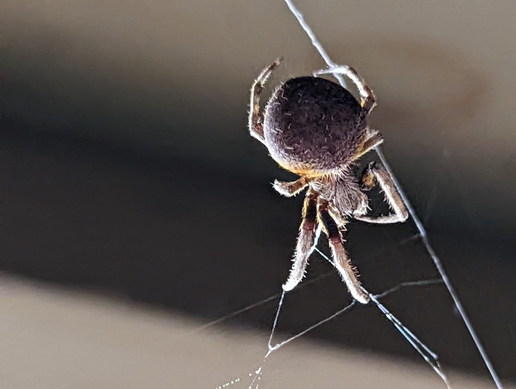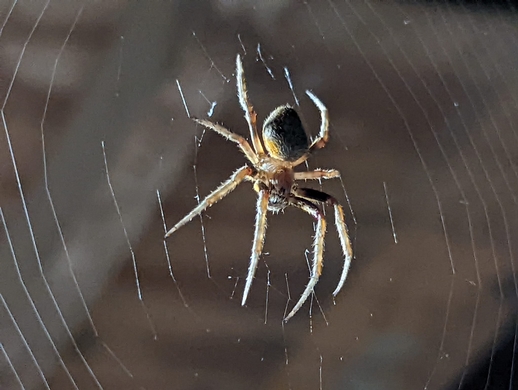by M. Kathy Raines
“I’m going out to check on my spiders!” I declared as I traipsed into the darkness for one last look at backyard wildlife. No, of course, they’re not my spiders. Wild creatures are not pets. Yet, I became oddly attached to these two Tropical Orb Weavers, which, each night this June, wove gigantic geometric masterpieces in roughly the same locations along the eaves of our shed.

I admire their mastery, industry, and rapt attention to detail. When my dog or I clumsily ripped a section of a spider’s three or four feet of delicate webwork, the diligent creature, not stopping to scold, unfurled new silk and went right to work repairing the damage. To dine that night, the spider required a massive web whose sticky parts would entrap mosquitoes and other insects. Such is a tropical orb weaver’s evening.
Many nights I watched as an orb weaver made its detailed creation, first making a bridge between boards, sometimes repeating its steps to thicken silk strands, then dropping on a thread it fastened to the bridge, expanding and reinforcing the structure before it began its spirals. It spins silk of various thicknesses and stickiness.
These orb weavers, like many, create their elaborate bicycle-wheel webs each evening and devour these protein-rich constructions before daybreak, leaving only support lines for the next day’s creation. In daytime, they conceal themselves in a nearby leaf or man-made structure.
Once it has finished construction, the spider sits upside down, legs resting on radial spokes which report vibrations, from which the spider can discern the wind, a mate, leaf or a struggling victim. It bites an insect, immobilizing it, then wraps it in silk before consumption.
The goddess Athena must have transformed gifted weaver Arachne into an orb weaver, with its stunning, intricate web, when she bested the goddess at a weaving contest.
One evening, no silky, geometric patterns obstructed my nighttime view; one orb weaver had disappeared. Was it me? I thought. Was it the nightly, albeit brief, glare of my cellphone near its face? My dog’s or my occasional slashing of its web? Telling my five-year-old granddaughter that maybe a bird, lizard or other creature ate it, she replied, “No, Grandma, maybe it said, ‘I’m getting bored of this place! I think I’ll move!’” Soon, the other spider had disappeared, too.
Joseph Connors, spider enthusiast with the South Texas Border Chapter of Texas Master Naturalists, noted that, since these orb weavers are nocturnal, “diurnal predators would need to find them early in the morning while they are taking down their web or find them in their hiding spots.” Spiders are rich in the amino acid taurine, he said, which is “important to early baby bird development.” The orb weavers I had observed could have died of old age, he surmised. They don’t usually live longer than a year.
A tropical orb weaver may be abducted and paralyzed by a mud dauber wasp, which places spiders in cells of its adobe-like nest to feed its soon-to-hatch larvae. Here is a video demonstrating this phenomenon:
https://www.facebook.com/tiffany.kersten/videos/1189665845147511/?flite=scwspnss

The tropical orb weaver (Eriophora ravilla) derives its genus name, which it shares with other orb weavers, from Ancient Greek terms for “wool-bearing”. A female Tropical—which one generally sees more frequently— can reach almost an inch in diameter, while a male is half to two/thirds its size. Females, whose bodies are covered with hair-like spines, have round abdomens. Markings on their backs, which vary, are often streaked with greenish or whitish colors and may bear a rectangular or diamond patch. The smaller male usually has a dark gray abdomen, banded legs and a deep groove on its carapace. “Juveniles of this species,” Connors said, “have a nice green spot on their back” and “two eye spots on top of the abdomen to confuse predators.”
The tropical orb weaver, a common local spider, thrives in woods, orchards and yards, especially along the Gulf Coast, and southwards into Mexico, Central America and northern South America.
A tropical orb weaver, like any local spider other than the black widow or brown recluse, poses scant danger to Valley residents and pets, unless they have an allergic reaction to its extremely uncommon bite. Also, spiders help cut down on mosquitoes.
We do ourselves, and especially our children, a grave disservice when we further the myth that spiders are scary or “yucky”—despite our chagrin when, after a nighttime collision with a web, we find spider silk glued to our arms and hair. (It’s much worse for the spider!).
Also, unlike other fascinating locals—say, the beautiful speckled racer or Painted Bunting—tropical orb weavers and other spiders are busily constructing or sitting in their webs right outside our backdoors. From a bedroom window, we’ve enjoyed watching excellent specimens on webs hammocked between spikes of a century plant.

Leave a Reply